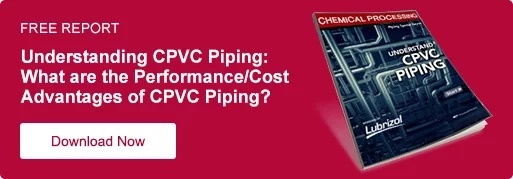Limiting Downtime When Plant Upgrades are Needed
Downtime can be a significant financial burden for an industrial plant, taking a toll on the facility’s productivity and bottom line. Planning for an approaching upgrade to a plant’s piping system can help expedite the update while limiting downtime and minimizing costs.
Industrial facilities will inevitably need to upgrade their piping systems – whether to make alterations to an existing system or replace it with a more efficient alternative. Understanding the piping materials that are available and learning how to work with the material selected for a project will help ensure the updated system is operational in a timely manner and will reduce downtime.
A Switch to Non-Metallic Piping
Metal piping was often the material of choice for industrial facilities in the past based on the material’s familiarity and availability. Industrial plants, however, are becoming more concerned about safety and avoiding processes and equipment that can cause sparks that create fire hazards.
As stream chemistries continue to evolve, the complex stream compositions can be problematic and corrosive to metallic systems. Many plants, therefore, are considering non-metallic piping systems such as Corzan® CPVC as a safer piping system option.
Corzan CPVC piping has proven during the past 60 years to be rugged and reliable and quicker and easier to install, which helps minimize downtime. Metal piping requires specialized welding techniques and highly skilled labor, thereby increasing installation time and costs. Corzan pipe installations can be completed onsite with or without pre-fabrication and by workers who can be trained in ASME B31.3 bonder techniques.
In addition, Corzan piping is much lighter than metal and eliminates the sprains and strains workers may suffer when they move and install metal piping. Corzan’s lighter weight requires fewer workers and less equipment and heavy machinery during installation compared to metal piping.
Solvent Cement for Reduced Downtime
Solvent cement is generally the preferred method to join Corzan CPVC piping. The substance chemically fuses pipe and fittings together at a molecular level to create a uniformly bonded piece of thermoplastic. The resulting joints become stronger than either the piping or fittings alone.
Corzan CPVC’s innovative technology is easier to cut than metal piping and other materials, allowing for more efficient fabrication, which is common. Having the versatility to cut and then join the piping system with solvent cement speeds the installation of thousands of feet of piping, which reduces labor requirements for major lines.
The set and cure times for solvent cement will depend on conditions such as pipe size, temperature, relative humidity and tightness of fit – although the cure time needed for most common pipe sizes will be minimal compared to the installation time required for metal piping. Drying times are faster in drier environments and with smaller pipe sizes, higher temperatures and tighter fits.
Any plant maintenance engineer or mechanical contractor can install or modify a CPVC system once he or she receives the proper training. ASME B31.3 bonder training is available and highly recommended for all installers.
Flanging to Speed Piping System Updates
As a safe and reliable option, flanges are able to absorb the stresses resulting from the expansion and contraction common to many piping systems. They also provide years of service.
Flanges used with CPVC piping incorporate an elastomeric gasket between the mating faces to provide a seal. A pipe gasket is generally 1/8-inch thick and must be chemically compatible with CPVC and resistant to the process chemicals to which it will be exposed. The Corzan Chemical Resistance Chart shows the CPVC material’s compatibility with more than 400 different chemicals. The gasket material must also be compatible with the piping material and able to withstand the elevated temperatures that are likely part of the process.
Flanges must be properly aligned and bolts inserted through matching holes during installation. The following illustration shows the alternating sequence to use when partially tightening each bolt.

Proper torque is also essential to ensure the flange is not damaged. Corzan partner manufacturers should be consulted for guidance based on their specific piping system design.
Reducing Future Downtime
Selecting a piping system that is quick and easy to install reduces downtime and lost productivity. A system designed for reliable, long-term performance will also decrease downtime in the future.
Quality Corzan CPVC piping offers advantages such as internal and external corrosion resistance, excellent hydraulic capabilities and the ability to handle elevated temperatures and pressure for durable, long-term performance.
Corzan CPVC piping has 60 years of success across industries worldwide and is offered in diameters up to 24 inches to meet the needs of most industrial plant applications. Corzan pipe and fittings are also available globally through Corzan’s partner manufacturers. Contact a Corzan CPVC piping system expert for application engineering support or to schedule a free technical consultation.
Details for this blog were taken in part from the following:
https://www.corzan.com/blog/metal-v.-cpvc-industrial-piping-systems-onsite-installation-process
https://www.corzan.com/blog/threading-and-flanging-cpvc-piping-systems


